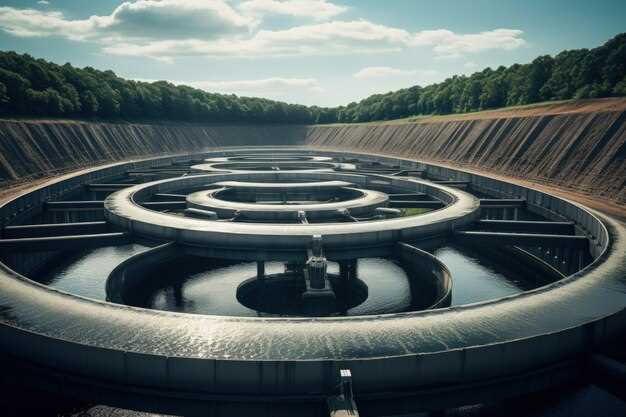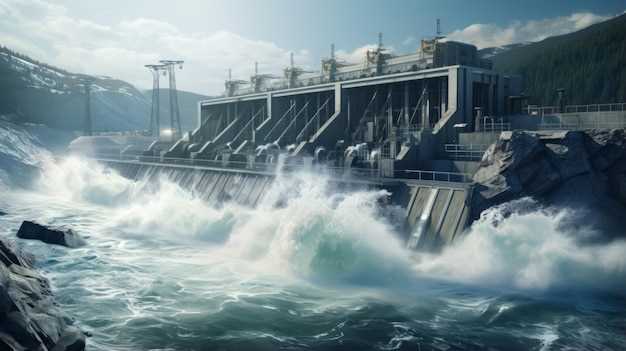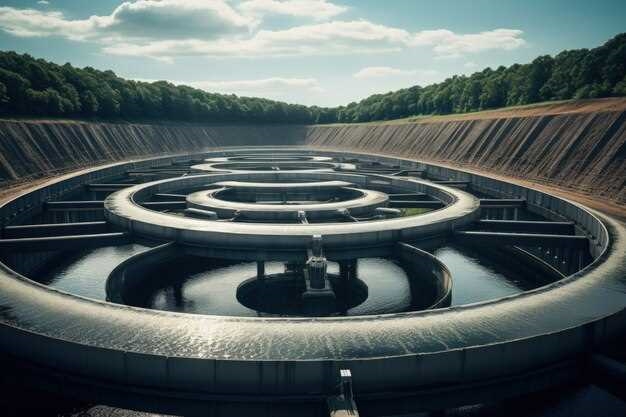
Renewable energy sources have become a focal point in the quest for sustainable and clean energy solutions. Among these sources, hydroelectric power stands out as a promising option, harnessing the power of flowing water to generate electricity. This article delves into the unexplored possibilities and the obstacles that lie ahead in the realm of hydroelectricity.
Hydroelectric power, often referred to as water power, has long been recognized as a reliable and efficient source of energy. By utilizing the kinetic energy of water, hydroelectric plants can generate electricity on a large scale. The potential of this renewable energy source is immense, with vast untapped resources waiting to be harnessed.
However, the journey towards maximizing the potential of hydroelectric power is not without its challenges. One of the primary hurdles is the need for suitable geographical conditions. The availability of a sufficient volume of water and a significant drop in elevation are crucial factors for the successful implementation of hydroelectric projects. Identifying suitable sites and ensuring minimal environmental impact are essential considerations in the planning and development stages.
Furthermore, the construction and maintenance of hydroelectric power plants require substantial investments and expertise. The design and engineering of dams, turbines, and transmission systems demand meticulous planning and execution. Additionally, the environmental impact of damming rivers and altering natural water flow patterns must be carefully assessed and mitigated to preserve ecosystems and protect biodiversity.
The Advantages of Hydroelectric Power: A Sustainable and Renewable Energy Source
Harnessing the power of water to generate electricity offers numerous benefits, making hydroelectric power a sustainable and renewable energy source. This method of energy generation utilizes the natural flow of water, providing a reliable and consistent source of power without depleting finite resources or emitting harmful greenhouse gases.
One of the key advantages of hydroelectric power is its environmental friendliness. Unlike fossil fuel-based power plants, hydroelectric facilities do not produce air pollution or contribute to climate change. The use of water as a fuel source means that hydroelectric power is a clean energy option, reducing the carbon footprint and promoting a healthier environment.
Additionally, hydroelectric power is highly efficient and cost-effective. The energy conversion process in hydroelectric plants is more efficient compared to other forms of energy generation. This means that a higher percentage of the potential energy in water can be converted into electricity, resulting in greater overall efficiency and lower operating costs.
- Hydroelectric power plants have a long lifespan, typically lasting for several decades. This longevity ensures a stable and reliable source of electricity for communities and industries.
- Hydroelectric power is also highly flexible, allowing for quick adjustments in electricity production to meet changing demand. This flexibility is crucial in maintaining a stable power grid and ensuring a consistent supply of electricity.
- Furthermore, hydroelectric power plants provide additional benefits beyond electricity generation. The reservoirs created by damming rivers can be used for recreational activities such as boating, fishing, and water sports. These reservoirs also serve as water storage for irrigation, flood control, and drinking water supply.
In conclusion, hydroelectric power offers numerous advantages as a sustainable and renewable energy source. Its environmental friendliness, high efficiency, long lifespan, flexibility, and additional benefits make it a viable option for meeting the growing energy demands of the future while minimizing the negative impact on the planet.
The Role of Dams in Hydroelectric Power Generation: Benefits and Environmental Concerns
Examining the significance of dams in harnessing the potential of water resources for electricity production unveils a multitude of advantages and ecological considerations. Dams play a pivotal role in facilitating the generation of hydroelectric power, offering numerous benefits while also raising concerns about their impact on the environment.
Benefits:
One of the primary advantages of dams in hydroelectric power generation is their ability to store vast amounts of water, creating a reliable and consistent source of energy. By regulating the flow of water, dams ensure a steady supply of electricity, reducing the dependence on fluctuating weather conditions. This stability makes hydroelectric power an attractive option for meeting the energy demands of communities and industries.
Dams also provide opportunities for water management, enabling the control of floods and the regulation of water levels in rivers. This feature helps mitigate the risks associated with extreme weather events, protecting downstream areas from potential damage. Additionally, dams can facilitate irrigation systems, supporting agricultural activities and enhancing food production in regions with limited water resources.
Environmental Concerns:
While dams offer significant benefits, their construction and operation can have adverse effects on the environment. The creation of reservoirs behind dams often leads to the displacement of local communities and the loss of valuable ecosystems. The submergence of land and habitats can result in the loss of biodiversity and disrupt the natural balance of ecosystems.
Furthermore, the alteration of river flow caused by dams can impact downstream ecosystems, affecting the migration patterns of fish and other aquatic species. The obstruction of rivers can hinder the natural movement of sediments, leading to erosion downstream and affecting the overall health of river systems.
It is crucial to carefully assess the environmental impacts of dam construction and operation, implementing measures to mitigate these concerns. Strategies such as fish ladders and sediment management techniques can help minimize the negative effects on aquatic ecosystems, ensuring the sustainable development of hydroelectric power generation.
In conclusion, dams play a vital role in hydroelectric power generation, offering numerous benefits such as a reliable energy source and water management capabilities. However, their construction and operation also raise environmental concerns, necessitating careful planning and mitigation strategies to ensure the sustainable utilization of this renewable energy source.
Exploring Small-Scale Hydroelectric Systems: A Promising Solution for Rural Areas
Rural areas often face challenges in accessing reliable and sustainable sources of electricity. In this section, we will delve into the potential of small-scale hydroelectric systems as a promising solution to address the energy needs of rural communities. By harnessing the power of flowing water, these systems offer a renewable and environmentally friendly alternative to traditional energy sources.
Advantages of Small-Scale Hydroelectric Systems
Small-scale hydroelectric systems have several advantages that make them well-suited for rural areas. Firstly, they can be implemented in various locations, utilizing streams, rivers, or even small waterfalls. This flexibility allows for the adaptation of the system to the specific geographical features of the area, maximizing energy production.
Additionally, small-scale hydroelectric systems are highly reliable, providing a consistent and continuous source of electricity. Unlike solar or wind power, which are dependent on weather conditions, hydroelectric systems can operate year-round, ensuring a stable energy supply for rural communities.
Furthermore, these systems have a long lifespan and require minimal maintenance. Once installed, they can operate for decades with minimal intervention, making them a cost-effective solution for rural areas with limited resources.
Challenges and Considerations
While small-scale hydroelectric systems offer great potential, there are also challenges and considerations that need to be addressed. One of the main challenges is the initial investment required for the installation of the system. The construction of dams, turbines, and transmission lines can be costly, especially for rural communities with limited financial resources.
Another consideration is the potential impact on the local ecosystem. It is crucial to conduct thorough environmental assessments to ensure that the installation of the hydroelectric system does not harm the surrounding flora and fauna. Proper mitigation measures should be implemented to minimize any negative effects on the ecosystem.
Additionally, the availability of water resources needs to be carefully evaluated. The feasibility of small-scale hydroelectric systems depends on the consistent flow of water throughout the year. Adequate studies and measurements should be conducted to determine the water availability and its suitability for energy generation.
| Advantages | Challenges and Considerations |
|---|---|
| Flexibility in location | Initial investment |
| Reliable and continuous energy supply | Potential impact on the ecosystem |
| Long lifespan and minimal maintenance | Availability of water resources |
Overcoming Challenges: Addressing the Environmental and Social Impacts of Hydroelectric Power
As we delve deeper into the realm of harnessing the power of water to generate electricity, it becomes imperative to acknowledge and address the potential environmental and social impacts associated with hydroelectric power. This section aims to shed light on the challenges that arise from this renewable energy source and explore potential solutions to mitigate its negative effects.
Environmental Impacts
Hydroelectric power, while offering a clean and renewable energy alternative, is not without its environmental consequences. The construction of dams and reservoirs can lead to the displacement of wildlife, alteration of natural habitats, and disruption of aquatic ecosystems. Additionally, the fluctuation of water levels caused by hydroelectric operations can affect the migration patterns of fish and other aquatic species, potentially leading to a decline in biodiversity.
To address these environmental impacts, it is crucial to implement comprehensive environmental impact assessments prior to the construction of hydroelectric projects. These assessments should consider the potential effects on local ecosystems, wildlife populations, and water quality. Furthermore, the development of fish passage systems and the implementation of environmental flow regimes can help mitigate the negative impacts on aquatic species and maintain the ecological balance of rivers and streams.
Social Impacts
Hydroelectric power projects can also have significant social impacts on local communities. The construction of dams often requires the resettlement of communities, leading to the displacement of people and disruption of their livelihoods. Additionally, the alteration of river flows can impact downstream communities that rely on the river for agriculture, fishing, and transportation.
To address these social impacts, it is essential to involve local communities in the decision-making process and ensure their active participation in the planning and implementation of hydroelectric projects. This can be achieved through transparent and inclusive consultations, providing adequate compensation and support for affected communities, and promoting sustainable development initiatives that create alternative livelihood opportunities.
| Environmental Impacts | Social Impacts |
|---|---|
| – Displacement of wildlife | – Resettlement of communities |
| – Alteration of natural habitats | – Disruption of livelihoods |
| – Disruption of aquatic ecosystems | – Impact on downstream communities |
| – Potential decline in biodiversity | – Need for inclusive decision-making |
Innovations in Hydroelectric Technology: Maximizing Efficiency and Output

Advancements in hydroelectric technology have revolutionized the way we harness the power of water to generate electricity. This section explores the latest innovations that aim to enhance the efficiency and output of hydroelectric systems, paving the way for a more sustainable and reliable energy source.
One key area of innovation focuses on turbine design. Engineers are constantly striving to develop more efficient and durable turbines that can withstand the immense forces of water flow while maximizing energy conversion. By utilizing advanced materials and optimizing blade shapes, these new turbines can extract more energy from the flowing water, resulting in increased power output.
Another area of innovation lies in the development of smart grid integration systems. These systems enable better coordination and control of hydroelectric power plants, allowing for more efficient utilization of the generated electricity. By integrating with other renewable energy sources and implementing advanced monitoring and control technologies, hydroelectric power can be seamlessly integrated into the larger energy grid, ensuring a stable and reliable supply of electricity.
Furthermore, advancements in dam design and construction techniques have also contributed to maximizing the efficiency of hydroelectric power generation. Modern dams are designed to minimize water leakage and optimize water flow, reducing energy losses and increasing overall efficiency. Additionally, the integration of fish-friendly turbine designs and fish passage systems helps mitigate the environmental impact of hydroelectric power plants, ensuring the sustainability of aquatic ecosystems.
Lastly, the use of advanced data analytics and predictive maintenance techniques has revolutionized the operation and maintenance of hydroelectric power plants. By analyzing real-time data from sensors and employing predictive algorithms, operators can identify potential issues before they escalate, minimizing downtime and maximizing the availability of the power plant. This proactive approach to maintenance not only improves efficiency but also reduces operational costs.
In conclusion, the continuous innovations in hydroelectric technology are driving the industry towards higher efficiency and output. Through advancements in turbine design, smart grid integration, dam construction, and predictive maintenance, hydroelectric power is becoming an increasingly reliable and sustainable energy source, contributing to the global transition towards a greener future.
